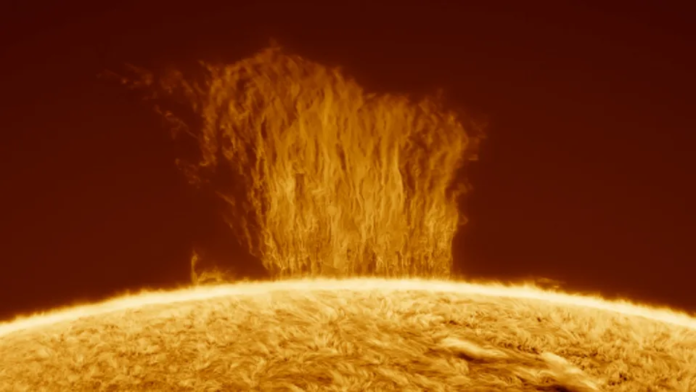
Astrophotographer Eduardo Schaberger Poupeau from Argentina recently captured a stunning portrait of a solar plasma burst that reached up to 100,000 kilometers above the surface of the sun. The relatively close distance of the sun allows observers to study the temperature and movement of the boiling plasma that rises and falls on its surface.
Plasma is a hot gas that flows up and down the surface of the sun, causing atoms to break down into smaller parts like electrons and ions due to its extreme heat.
Poupeau explained that the solar plasma burst was “about eight Earths stacked on top of each other” and that “hundreds of threads of plasma spread through the Sun’s atmosphere.”
These threads of plasma are known as plasma filaments, and they play a crucial role in the mechanism that produces solar storms, which ultimately can affect Earth.
This plasma burst phenomenon is known as the polar crown prominence (PCP), or the polar crown projection. It occurs near the magnetic poles of the sun at latitudes between 60 and 70 degrees north and south.
These prominences often collapse back to the sun due to the stronger magnetic field near the poles. The term “plasma waterfall” has become popular due to the plasma bursts that spray at a certain height, cool down, and then fall back to the surface.
However, researchers clarify that the plasma that erupts and falls is not free-falling, as it is contained within the initially vomited magnetic field. Despite this, the plasma still moves downward at speeds up to 36,000 km/h, which is much faster than the magnetic field.
Scientists are still trying to figure out how this phenomenon occurs, but a 2021 study published in the journal Frontiers in Physics revealed that PCP experiences two phases during its eruption: a slow phase when plasma slowly rises upward and a fast phase when plasma accelerates towards its peak height. These two phases may affect how plasma falls back to the surface, but more research is needed to confirm this.
PCP is not only studied by solar physicists, but also nuclear physicists because the sun’s magnetic field appears to be very skilled at holding plasma loops in polar areas, which can provide insights to help researchers improve experimental nuclear fusion reactors.
According to NASA, PCP is common and can occur almost every day, although phenomena like the one captured by Poupeau are rare. Like many other plasma-related solar phenomena, PCP can become more frequent and intense when the sun reaches its peak in the 11-year solar cycle known as the solar maximum.






















